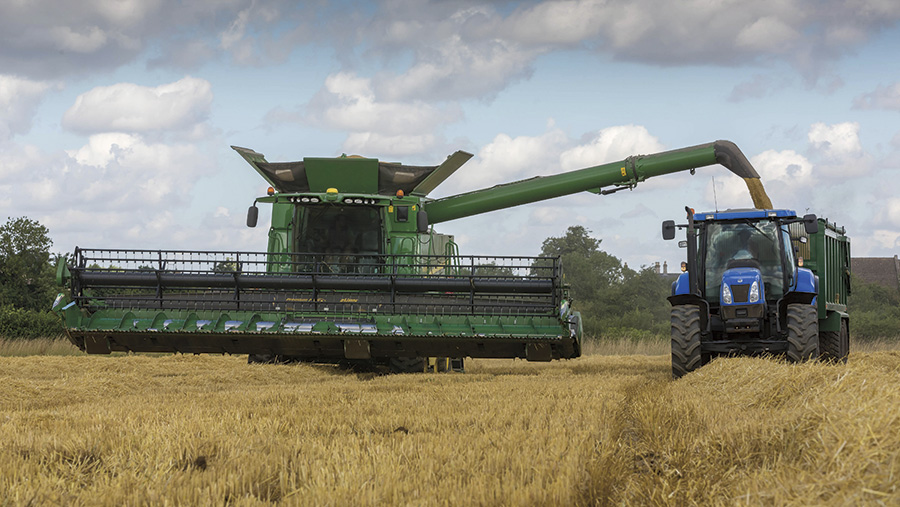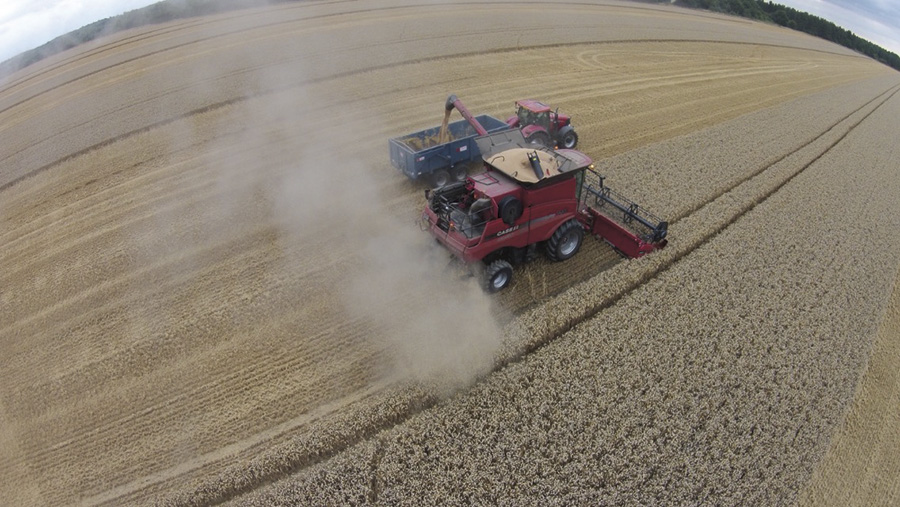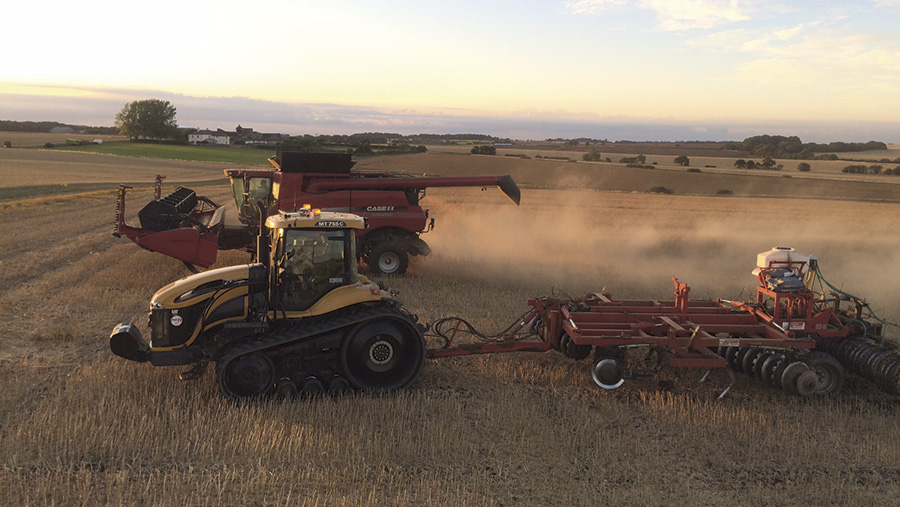What costs to consider when increasing combine capacity
Every year farmers face the same question: Should I buy extra kit to ensure a quick harvest and secure premiums, pay for a contractor, or risk rain delays?
Each carries its own cost – whether it’s a capital investment, in-year expenditure, or lost income through rain-damaged crops.
Of course, the summer may stay fine and bright, but statistically August is the wettest month of the year and once the rain arrives it will be too late to act.
So what’s the best option?

© Tim Scrivener
See also: Rules reminder: Stay road legal this harvest
According to Bidwells partner and consultant David Watson, farmers should not react to one wet harvest; instead they should plan for an average year.
“If you buy enough kit to cope with a worst-case scenario your fixed costs would be far too high to survive.”
The best option will not be the same for any two farms: It depends on the size of the farm, the cropping mix and the farmer’s attitude to risk.
Lean fleet
“Personally, I’m very keen on having a lean machinery fleet and getting decent contractors to fill the holes,” says Mr Watson.
Of course, the main risk with using contractors is their availability at busy times.
“It’s worth paying a premium to secure the best contractor for the right time.”
Too many producers have an expensive, top-of-the-range combine and only run it for 200 hours/year, resulting in high fixed costs and extortionate costs per hour, he warns.
“If you’ve chosen an old machine that’s going to clock up 2,000 hours in 10 years, that’s fine, but if you have an expensive combine you need to make it work, ideally for 400 hours/year, which may involve going contracting yourself.”
Those who are keen to preserve milling wheat quality should consider supplementing their own combine with a contractor, says Mr Watson.
“If you’re growing 500ha of milling wheat and risk losing 125ha to wet weather that equates to a loss of £18,750 (assuming a yield of 10t/ha and a premium of £15/t over feed wheat). Paying a contractor £75/ha to get that 125ha in quickly would therefore yield a net gain of £9,375.”
Consider the chain
However, it’s essential to consider the full grain handling chain before shelling out to speed up harvest, he warns.
“Do you have enough grain carts and drivers, as well as tipping and drying facilities to keep up with the combine? If not, it’s a recipe for disaster.”
According to Richard Means at Strutt & Parker, it’s important to consider the crop rotation and variety choice before incurring extra expense.
“A day’s combining in July is worth two in September, so look at maturity when choosing a variety.”
But what if you need to replace your combine? Do you go for a shiny new one, something second-hand, or perhaps contract hire?
A top-of-the-range new combine will cost about £250,000 – over five years that equates to about £50,000/year.
“You can get some very good zero percent finance terms,” says Mr Watson. A hire purchase agreement will spread the cost, but will incur interest payments.
Buying new also offers the maximum control in matching the best technology to your requirements, says Mr Means.
For example, steering guidance and management tools will maximise the work output of the machine.
Another alternative could be to form a joint venture with a neighbour, pooling the machinery costs.
Buying second-hand
A second-hand equivalent with, say, 700 hours on the clock, would cost about £140,000; £28,000/year, with an ex-demo machine somewhere in between.
“But do your homework,” says Mr Means.
“Has it come from stony ground; has it been driven by the same person or by different harvest casuals every year? Has it had full manufacturer’s warranty and service packages?”
Reliability is key. “If you buy second-hand you can afford to spend a lot more on repairs, but it’s the opportunity cost if it breaks down at a critical time,” says Mr Watson.
“Pre-season checks are worthwhile, as is knowing if you can get something repaired quickly.”
Hired machines can offer good flexibility if a business is changing in size or has a concentrated workload, says Mr Means.
They usually come with a mandatory service agreement, and typically cost about £55,000/year for a top range combine.
Another alternative could be a short-term hire, at a cost of about £25,000, but that would usually only be for the first half of harvest, warns Mr Watson.
After harvest
So what about after harvest? Getting winter crops drilled into good conditions is just as important as getting them in the barn, so is it worth upgrading drilling kit to speed up operations?
“In the Midlands and East of England blackgrass is the single biggest driving force on many arable farms,” says Mr Watson.
“The first week of October is still the ideal drilling date for winter wheat, but many farmers are pushing that to the end of October for better blackgrass control.”
As a result, the drilling window is extremely narrow, so it could be worth buying a larger capacity drill or using a contractor to speed up the process.
“Even at current second-hand values a 6m cultivator drill will cost £25,000-£30,000, compared with a contractor at £45/ha.”
Assuming 500ha of wheat needs to be drilled, it makes most sense to drill 350ha using the farm drill – at 70ha per day that will take five days. Then use a contractor to drill the remaining 150ha at a cost of £6,750.
“Compared with drilling early you’re going to save about £60/ha on blackgrass herbicides across the whole 500ha,” says Mr Watson.
“That’s a saving of £30,000 for an outlay of £6,750.”
Tax perspective
When restructuring a farm’s machinery fleet, it’s important to plan ahead to maximise the tax efficiencies, says Andrew Vickery, head of rural services at accountant Old Mill.
“If you’re selling or part-exchanging old machinery that you’ve already claimed tax relief on, you could be crystallising a taxable profit, so speak to your accountant before making any decisions.”
Whether buying new or second-hand kit, it should be possible to claim the annual investment allowance (AIA), giving 100% tax relief on up to £200,000/year. Any expenditure above that can be written down at 18% a year.
Of course, tax relief is only a benefit if the business is making a profit to offset. Fortunately, farmers can carry the relief back against prior year profits, or offset it against future profits from the same trade.
“You may be able to use it against non-farming profits but there are restrictions on this,” says Mr Vickery.
Other considerations include part-exchanges and hire purchase: In the former, the AIA is granted on the full value of the new machine, not the net value after the part-ex.
“It could be worth negotiating a reduced sale price with your dealer to maximise the tax relief available.”
With hire purchase, the date on which the AIA can be claimed is typically when the machine is delivered on-farm. Tax relief is given on the capital value and cannot be sought on the monthly repayments.
Contract hire and contracting agreements are treated very differently: The payments are simply treated as expenses which can be offset against profits in-year for income tax purposes.
“You could argue that you’re avoiding the cost of depreciation by not owning your own kit, but in reality those costs will be built into the fees,” says Mr Vickery.
Case study: Andy Clark, Saffron Walden, Essex
Andy Clark has looked closely at his machinery fleet in recent years, having expanded from a 120ha family farm near Saffron Walden, Essex, to 810ha under four contract farming agreements.
“We are always looking to reduce our costs and keep up with efficiencies – it’s a trade off between what you would like and what you can afford,” he says.
The business has a group grain store, through which drying costs are shared, and Mr Clark essentially runs the 810ha as one farm.
“It’s quite spread out so we’re trying to stretch harvest by growing winter barley at one end and spring beans at the other.
“We also grow a lot of milling wheat and seed – we cannot afford for them to spoil so they are prioritised.”
Mr Clark likes to own any heavily used pieces of machinery such as key tractors, sprayers, drills and the combine, but will hire in extra equipment as needed.
The Case Axial Flow combine does about 400 hours/year, and will probably remain in the fleet for six to eight years.

“I like to buy new combines as the warranty is important – we have a service contract with the dealership which does a pre-season check.”
Other machinery may be second hand or ex-demo, and is either maintained on-farm or through the dealer.
“If we take on extra land we’ll probably hire another combine or whatever we need: The agreements are usually three to five years so you don’t want to be left with an expensive piece of kit if the agreement fails,” says Mr Clark.
Given he has the manpower available, hiring is a good alternative to using contractors. “Where we are, all the contractors are pretty fully committed, so if harvest is getting behind they can’t just come straight over to help out. However, we do use contractors for muckspreading,” he adds.
“We don’t have a fixed replacement policy; if we start to get reliability issues we’ll look to replace it.”


